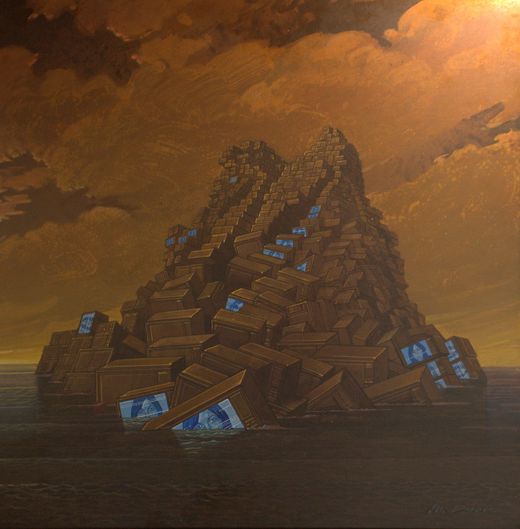

France
Biography
Michel Dubré. French. Born in Paris. As a child, Dubré roamed the bustling streets of the Batignolles district, the Butte Montmartre, Pigalle and Place Clichy on foot. The Sacré-Cœur, the Church of the Trinity, the Department Stores are on its way, but also, close by, the "wastelands" of the fortifications of post-war Paris, shifted, muddy, poorly frequented, in pain. He still walks the desert dunes of the northern beaches, with their off-center blockhouse remains that slowly drown in a sand so fine that it becomes liquid. Later, a student at Estienne, he regularly crossed Paris to return home ... Place d'Italie, Jussieu, rue Mouffetard, the Panthéon, the "Boul'Mich" (he was one of those who made the first "chalks" on the sidewalks of the City), Notre-Dame, les Halles, the Louvre Palace, the avenue de l'Opéra, the avenue des Champs-Elysées ... Stations, landscapes, steps (later towards the South) , which will strongly mark his work as an artist. At 17, he saw his first poster published (for the Trocadéro aquarium in Paris), but continued artistic studies. Winner of an incentive prize, he made several study trips to Florence. On board a 2CV, he also explores the countries of Europe and the Mediterranean Basin, multiplying notes and sketches. During this whole period, he accumulated various artistic experiences and productions: drawings, collages, graphics, typography, paintings. After having started with the demanding discipline of lithography, he graduated from the Ecole Supérieure Estienne. He studied at the Applied Arts in Paris. Then he was received at the Ecole Normale Supérieure in Cachan. Professors such as Albert Flocon (Bauhaus student, Intimate of Escher), Jean Cluseau-Lanauve, René Letourneur, Pierre Noël Drain, mark his apprenticeship. He then discusses space, volume, design. He teaches at the National Education, as certified teacher, from 1966. He develops his creations, through theater, street theater, urban space, scenic space, theater poster , the cinema. He draws several animated films at ECPAD, including the "Rendez-vous de l'Iroise" which won a palme d'or in 1968. In the early 1970s, Dubré returned to drawing and painting with new " visions ", often of oversized scale, using figuration. His ambiguous landscapes and "expatriations" evoke themes of human ecology and utopian urbanization. Paris inspires him. He "sets up" his first wheat fields in the Capital. At the Champs-Elysées, Avenue de l'Opéra. The media then became interested in his work and offered him numerous collaborations in the fields of the press, publishing and advertising. In 1976, he carried out a major advertising campaign for Air France and the Concorde aircraft, which won most of the international graphic arts awards. It allows France to obtain the Palme d'Or of the CLIO in New York. Dubré alternates a maniacal painting and drawing work depicting "insane spaces" with a three-dimensional work - conceptual taking on reality and materialized utopia (objects, diversions, crafts, installations). The artist practices ceaseless "back and forth" between his paintings, drawn mythologies and his "materialities" in three dimensions. He reinstalls his "installations" in his own pictorial universe. In 1978, for the Center Georges Pompidou (Paris), he created one of his first "assemblages" as part of the exhibition "Le Temps des Gares". Installation featuring neon, barbed wire, gyroscope, Center Pompidou waste and black paint. Through his paintings and his "materialities", his enigmatic, often ironic assemblages are marked by the change of scenery (Dépaysages), like his wheat fields, installed in Paris, on the Champs-Elysées. He then worked on the "Muages" series. Between heaven and earth, between naturalness and artifice, materiality and spirituality. The Muages reveal an obsession with ties, ropes and networks. The artist's new paintings, presented by the Alain Blondel Gallery in 1996, in Paris, show a new series devoted to the artificial light of cities, to the storage of "blank canvases", to the cathode light dumps stationed in the streets. We can see that the artist's "materialities" are once again "recycled" in his paintings. The Villa Medici, Museum of Saint Maur des Fossés, presents a first retrospective of his work bringing together around two hundred works. In 2000, the artist created a new painting installation "Muages Mémoire WWW. 1999" (IBM Foundation), reinstalled on the screen, on the set of Antenne 2 for the program "Bouillon de Culture" (Bernard Pivot) . From 2001 to 2009, Michel Dubré developed new "Dépaysages Projects" for Paris and other capitals. He draws and exhibits, on different occasions, new paintings. For example, "Eiffel Tower", "Suspension" and "U-wheat Champs Elysées", at the Grand Palais in Paris, as part of "d'Art en Capital, Comparaisons". He is currently working on his next exhibition. And also… He takes part in various teaching and research missions. Professor at the Académie Charpentier (Paris), Superior School of Interior Architecture, Visual Communication and Graphic Design. Vice President of the SNPI, he contributes to the development of the law on copyright in advertising. Director of studies for the Ministry of Culture and the Ministry of National Education, he contributed to the rehabilitation of part of Vauban's fortifications in Belfort (La Tour 41), as well as to the creation of the Cultural Center of the city, with the CDEP. Deputy Mayor for the enhancement of the heritage and urban planning of the city of Saint-Maur-des-Fossés, he worked on the realization of several architectural and urban projects and contributed to the awareness of the inhabitants to their architecture by L 'Exhibition "Architectures of Saint-Maur, Living Heritage" presented by the Museum of Saint-Maur, Villa Medici. The directory of remarkable architectures, in collaboration with the CAUE of Val de Marne.
Read more
Nationality
Exhibitions dedicated to Michel Dubré
Discover the movements linked to Michel Dubré
Discover our selections of works by artists
Need help finding your favorite? Consult our selection pages made for you.





